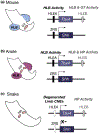Diversification of the vertebrate limb: sequencing the events
- PMID: 33647833
- PMCID: PMC8364862
- DOI: 10.1016/j.gde.2021.02.005
Diversification of the vertebrate limb: sequencing the events
Abstract
Naturalists leading up to the early 20th century were captivated by the diversity of limb form and function and described its development in a variety of species. The advent of discoveries in genetics followed by molecular biology led to focused efforts in few 'model' species, namely mouse and chicken, to understand conserved mechanisms of limb axis specification and development of the musculoskeletal system. 'Non-traditional' species largely fell by the wayside until their recent resurgence into the spotlight with advances in next-generation sequencing technologies (NGS). In this review, we focus on how the use of NGS has provided insights into the development, loss, and diversification of amniote limbs. Coupled with advances in chromatin interrogation techniques and functional tests in vivo, NGS is opening possibilities to understand the genetic mechanisms that govern the remarkable radiation of vertebrate limb form and function.
Copyright © 2021 Elsevier Ltd. All rights reserved.
Conflict of interest statement
1. Conflict of Interest
Potential conflict of interest exists:
We wish to draw the attention of the Editor to the following facts, which may be considered as potential conflicts of interest, and to significant financial contributions to this work:
The nature of potential conflict of interest is described below:
No conflict of interest exists.
We wish to confirm that there are no known conflicts of interest associated with this publication and there has been no significant financial support for this work that could have influenced its outcome.
Figures



References
-
- Zeller R, López-Ríos J, Zuniga A: Vertebrate limb bud development: moving towards integrative analysis of organogenesis. Nature Reviews Genetics 2009, 10:845–858. - PubMed
-
- Towers M, Tickle C: Growing models of vertebrate limb development. Development 2009, 136:179–190. - PubMed
-
- Levy SE, Myers RM: Advancements in Next-Generation Sequencing. Annu Rev Genomics Hum Genet 2016, 17:95–115. - PubMed
-
- Roscito JG, Sameith K, Parra G, Langer BE, Petzold A, Moebius C, Bickle M, Rodrigues MT, Hiller M: Phenotype loss is associated with widespread divergence of the gene regulatory landscape in evolution. Nat Commun 2018, 9:1–15. - PMC - PubMed
-
●● A comprehensive study that uses functional and comparative genomic approaches to identify conserved non-coding elements (CNEs) across animal genomes. Alignments of 29 vertebrate genomes were used to discover and calculate divergence of CNEs in genomes of snakes and subterranean mammals, such as moles. Extensive sequence divergence in CNEs near limb developmental or eye-related genes was associated with limb loss in snakes and eye degeneration in subterranean mammals, respectively.
Publication types
MeSH terms
Grants and funding
LinkOut - more resources
Full Text Sources
Other Literature Sources

